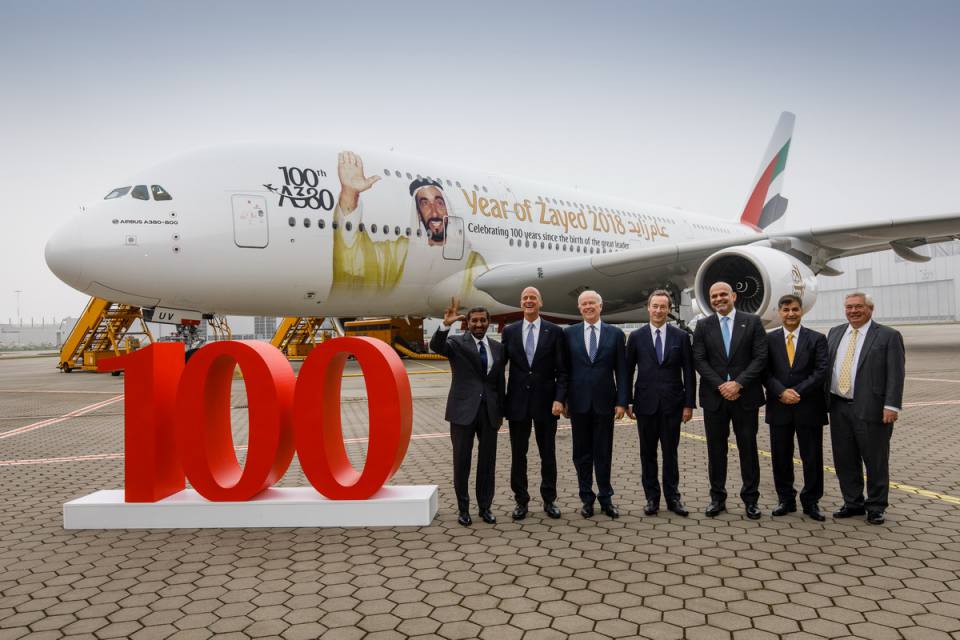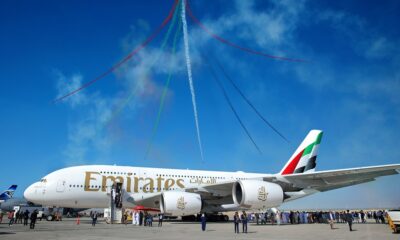Aerospace
Emirates welcomes 100th A380 to its fleet

- Celebrates milestone delivery in Hamburg, reaffirms commitment to A380 programme
- Emirates chairman highlights positive impact of Emirates’ A380 operations on aerospace manufacturing, aviation industries and consumer experience
DUBAI, U.A.E., 3 November 2017 – Emirates today celebrates the milestone delivery of its 100th Airbus A380 aircraft at a special ceremony with Airbus at the manufacturer’s delivery centre in Hamburg.

His Highness Sheikh Ahmed bin Saeed Al-Maktoum, Emirates’ Chairman and Chief Executive officiated the ceremony. He was joined at the event by Sir Tim Clark, President Emirates Airline; Tom Enders, Airbus Chief Executive Officer; Dominic Horwood, Rolls-Royce, Director – Customer and Services; His Excellency Ali Al Ahmed, UAE Ambassador to Germany and Frank Horch, Senator for Economy, Transport and Innovation of the Free and Hanseatic City of Hamburg.

Sheikh Ahmed said: “This is a tremendous moment for Emirates, for Airbus and for our many partners involved in the A380 programme. There is no doubt that the A380 has had a big positive impact on aerospace manufacturing and the broader aviation industry, supporting hundreds of thousands of jobs and stimulating innovation and new product development in many related areas such as ground handling, catering, airport facilities and cabin products, to name a few.
“Importantly, the A380 also brought the flying experience for our customers to the next level. The aircraft itself is a showpiece of engineering. It is the world’s largest commercial passenger jet but it is quiet and efficient and at Emirates we’ve utilised the onboard real estate to redefine the thinking around inflight products and experience. Our flight crew love to fly it and our customers love to fly in it.
“For Emirates, the A380 has been a success. We’ve been able to utilise it at slot-constrained airports, as well as at regional and ‘secondary’ airports where we have grown passenger demand. Each time we deploy an A380 onto a route, it typically stimulates further traffic and demand as travellers are attracted by our flagship A380 experience. We remain committed to the programme and will work closely with Airbus and our partners to continually enhance our A380 product as we look ahead to receiving our remaining 42 aircraft on order.”
“We are extremely proud of our long-standing relationship with Emirates – a partnership that has been integral to the A380 programme,” said Tom Enders. “It is a source of immense satisfaction for everyone at Airbus that such a visionary airline has believed in the A380 from the beginning and chosen it as its flagship and the backbone of its operations. And, of course, it is always exciting to hear positive feedback from our customers and passengers about the aircraft, while associating it with Dubai’s success as the world’s most dynamic air transport hub.”
Dominic Horwood said: “We would like to congratulate Emirates on this momentous occasion. We are very proud to be powering their 100th Airbus A380 and look forward to building on our strong relationship in years to come.”
Powered by Rolls-Royce engines, Emirates’ 100th A380 is configured in three cabin classes, with 14 private suites in First class, 76 seats in Business and 426 seats in Economy. It also features the airline’s newly revamped Onboard Lounge. It will be on display at the upcoming Dubai Air Show and will enter service afterwards.

Aerospace
Which is bigger 777x or 787 aircraft ?

The 777X is a new series of the Boeing 777 family and is designed to be larger and more efficient than its predecessor. It features two variants: the 777-8 and the 777-9, being the larger of the two.
The Boeing 777X emerges as the larger sibling within the Boeing family, representing a significant leap forward in both size and efficiency. Comprising two variants, the 777-8 and the 777-9, the latter takes the crown as the larger of the two. With its expansive fuselage and impressive wingspan, the 777X is tailored for long-range journeys and boasts a substantial passenger capacity.
On the other hand, the Boeing 787, affectionately known as the Dreamliner, occupies a niche in the market as a smaller yet formidable aircraft designed for medium to long-range flights. Its distinguishing feature lies in its composite fuselage, a technological marvel that renders it lighter and more fuel-efficient compared to conventional aluminum counterparts. The Boeing 777X is larger than the Boeing 787 aircraft.
When it comes to passenger capacity, the 777-9 reigns supreme, typically accommodating a sizeable contingent of 400-425 passengers in its standard configuration. In contrast, the 787, with its more modest dimensions, typically carries between 240-290 passengers, depending on the variant and layout.
One of the remarkable innovations introduced with the 777X is its folding wingtips, a feature designed to address the logistical challenges of accommodating such a large aircraft in conventional airport gates. These folding wingtips enable the 777X to retract its wings, allowing it to fit into gates designed for smaller aircraft while still reaping the benefits of an extended wingspan during flight, thereby enhancing fuel efficiency and operational flexibility
Aerospace
China Secures Production Certificate for Mass Production of Pilotless eVTOL Aircraft

The first passenger-carrying pilotless electric vertical takeoff and landing (eVTOL) aircraft in the world, the EH216-S, has received the Production Certificate for its eVTOL aircraft from the Civil Aviation Administration of China (CAAC).
This is a significant milestone for EHang Holdings Limited, the leading UAM technology platform company in the world. This outstanding accomplishment is another big step towards mass manufacturing for the eVTOL aircraft and the ensuing commercial operations, building on the ground-breaking acquisition of the Type Certificate and the Standard Airworthiness Certificate for the EH216-S.
The PC is a crucial certificate that the aircraft maker receives from the CAAC, the country’s aviation authority. By obtaining this certificate, EHang has demonstrated that it has set up a quality management system for mass production that satisfies the airworthiness regulation standards set forth by the CAAC, and the company has been given permission to continue producing mass quantities.
It is also a strong guarantee of the calibre of the goods made by EHang. Raw materials, supplier management, manufacturing organisation, production quality control, aircraft pre-delivery test, after-sales repair and maintenance, etc. are all included in the mass production quality management system for the EH216-S.
To ensure that every aircraft and its components that roll off the production line strictly adhere to the approved type design and safety requirements, the system sets clear guidelines and documentation for every step in the production procedure. This ensures comprehensive traceability and safety control.
Aerospace
Four Airbus A380 Superjumbos lined up to be scrapped

In a strategic move aimed at reclaiming valuable resources from the iconic Airbus A380 aircraft, VAS Aero Services and Dr. Peters Group have announced a significant collaboration.
This partnership marks a milestone in aviation logistics and aftermarket services, with four of these colossal planes slated for teardown and redistribution of used serviceable material (USM).
The venture between VAS Aero Services, renowned for its expertise in aircraft dismantlement, and Dr. Peters Group, a prominent Germany-based investment fund management firm, underscores a commitment to sustainable aviation practices. This isn’t their first foray into scrapping A380s; their successful partnership has already seen the dismantlement of these aircraft, making them pioneers in this niche.
Under the agreement, the latest consignment brings the tally to eight A380s entrusted to VAS by Dr. Peters Group. Managing Director Christian Mailly of Dr. Peters Group emphasized the trust placed in VAS, citing their unparalleled capabilities in dismantlement and aftermarket sales network. It’s a strategic move in response to the growing demand for quality USM parts, particularly with the resurgence in reliance on the A380.
Notably, the teardown process will be carried out at various locations, optimizing the positioning of harvested parts to cater to different markets. While some parts will be positioned in Europe to support operators in the region and the Middle East, others will remain in the Asia-Pacific region. This meticulous strategy ensures efficient access to spare parts, benefiting MROs and airlines across these markets.
The decision to retire these A380s comes at a time when operators are reassessing fleet strategies amidst evolving market dynamics. Despite initial plans for quick retirement due to the emergence of more fuel-efficient alternatives, factors such as a rebound in long-haul demand and delays in new widebody deliveries have prompted operators to reconsider. The A380, with its unique capacity and capabilities, presents a practical solution for short-term capacity management.


























